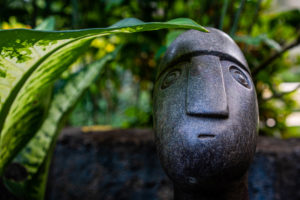Support Hidden Compass
Our articles are crafted by humans (not generative AI). Support Team Human with a contribution!
Portland, Oregon
It’s unbearably hot in Portland. Not humid, Pacific Northwest hot, but dry hot. Southern California hot. Desert hot.
Last night, lying awake in the canicule, the acrid scent of wildfire smoke rippling through the room, I finished Narcissa Whitman’s journal. In 1836 she and her new husband, Marcus Whitman, a doctor and Methodist missionary, began their journey on the Oregon Trail — a trek that made her and another traveler with their group, protestant missionary Eliza Hart Spalding, the first white women to cross the Rocky Mountains.
Their journey has captured my imagination ever since dying of dysentery in The Oregon Trail — the 1971 video game that taught a generation of American kids about the emigrant experience — was a near-universal schooltime affair. I’ve always wanted to travel the trail myself. I’ve always wanted to know what those 400,000 emigrants experienced almost 200 years ago — to know what it was like at that time, in that place — on a journey that forever changed the future of the West.
Traveling what was left of the trail in the summer of 2021, as drought and wildfires consumed the West, I felt a new sense of urgency. We are once again at a historical crossroads. As the changing climate takes an ever increasing toll, what will remain of not just the original Oregon Trail but of the fertile landscapes that seduced the emigrants into making an epic pilgrimage?
On the Oregon Trail I’m more exposed, more vulnerable.
So over four days that August, with Narcissa’s journal at my side, I drove a reverse version (west to east) of the path that the emigrants took through Oregon and Idaho. In 1836, Narcissa could only imagine the road to come. In 2021, climate science has already begun to reveal its path.
~~
After finding God at the age of 11, Narcissa was determined to spread Christianity to those she deemed most in need of saving. She and Marcus encountered dozens of Native American tribes along the trail, but they built their mission in the land of the Cayuse, in northeastern Oregon. Narcissa fully believed the tribe’s members “very eager to have teachers among them.”
Whether they were or not, the tribe never bargained for an education like the one they got.
The Oregon Trail was a lightning strike through the Indigenous communities of the Northwest. Within a single generation, the semi-nomadic lives they’d lived for millennia were left tattered and torn. By the 1860s, the U.S. government had forcibly removed most tribes from their homelands and resettled them on reservations, where inadequate resources and culturally inappropriate rules and demands became standard.
The upheaval and horror should have destroyed them. That’s what the U.S. government had bargained on, at any rate.
Instead, they endured.
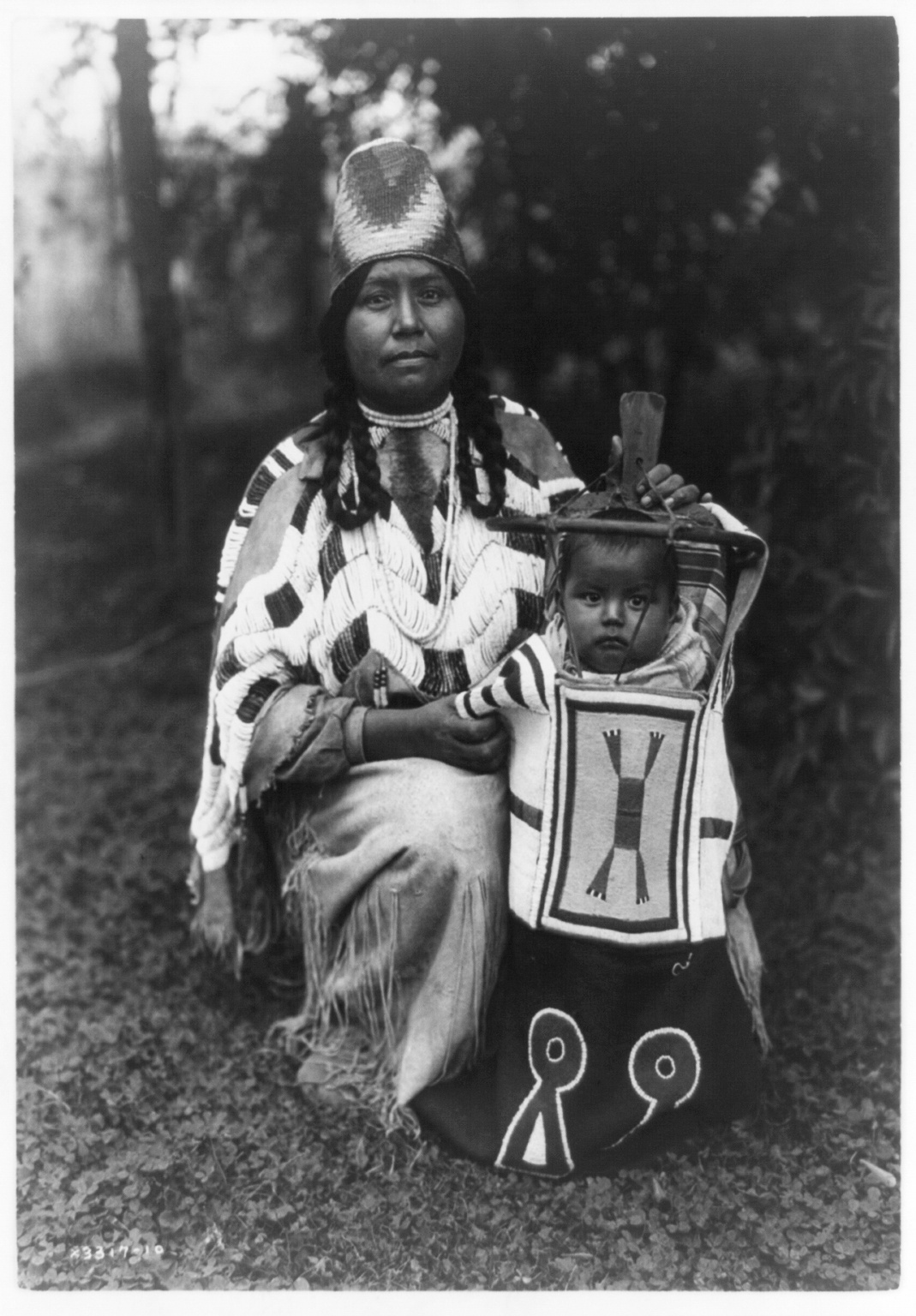
A Cayuse mother and her child in 1910. Photo: Edward S. Curtis/Library of Congress.
Before settling in Waiilatpu — “the place of the rye grass” in the Cayuse (Weyíiletpuu) language — the Whitmans traveled all the way to the trail’s end in the modern-day Portland metro area. “What a delightful place this is,” Narcissa wrote from Vancouver. It had “fruit of every description” and “every kind of vegetable too numerous to mention.”
Watered by the mighty Columbia and Willamette rivers, studded with verdant woodlands and valleys, Oregon was akin to Zion for the emigrants — the heaven that awaited them after a 212-day march toward manifest destiny.
And all that land seemed ripe for the taking. Though fur trappers and traders had used the route that became the Oregon Trail since the early 1810s, the successful 1836 traverse by the Whitmans’ party — one of the first emigrant parties — triggered one of the largest voluntary mass migrations in history.
Willamette Falls to The Dalles — 91 miles
2021: 90 minutes
1836: 3.5 days
Not everyone on the Oregon Trail was headed for what is now the Portland metropolitan area. The best way I’ve seen the route described is as a rope frayed at either end. People came from everywhere to gather in Independence, Missouri in preparation for the journey ahead. They all traveled the same path for more than a thousand miles, but once they reached the Columbia River, splayed out across the landscape.
Some, like Narcissa, went to Fort Vancouver, now a Washington-state suburb on Portland’s northern rim, to replenish their supplies and get their bearings. Others traveled to Oregon City on Portland’s south side, then down the fertile Willamette Valley.
It was over 100 degrees Fahrenheit on the morning when I reluctantly stepped out of the air-conditioning and into Oregon City. In 1829 the Hudson Bay Company, a British fur-trading outfit, settled this spot above the Willamette Falls — the most voluminous cascade in the Pacific Northwest — later building a mercantile to serve the arriving pioneers.
The falls were a problem for early emigrants. They prevented the passage of boats along this section of the Willamette River until 1873, when they were tamed by a series of locks. Now they just look like a giant bathtub drain.
As I stood watching the falls swirl into the river below, I shuddered in the heat, sweat pouring in rivulets down my back. I struggled to keep my breath steady through lungs cottony and thick. I wiped my streaming eyes, and all at once I understood: A blanket of wildfire smoke was enveloping Oregon City.
As I drove east, the smoke pried its pestilential fingers through the windows and reached into my throat. The haze was so thick that Mount Hood, Oregon’s tallest, most iconic peak, was completely obscured.
Though I couldn’t see the flames, the Columbia River Gorge was a gauntlet of wildfire. Just south of the highway the Bull Complex Fire was burning in Mount Hood National Forest. North of the gorge, fueled by aggressive winds and unrelenting heat, the Schneider Springs Fire had already devoured some 50,000 acres of the Okanogan-Wenatchee National Forest. More than 500 firefighters were battling the flames, but Level 3 evacuations — the “Go now, or else!” kind — were expected to be issued within days.
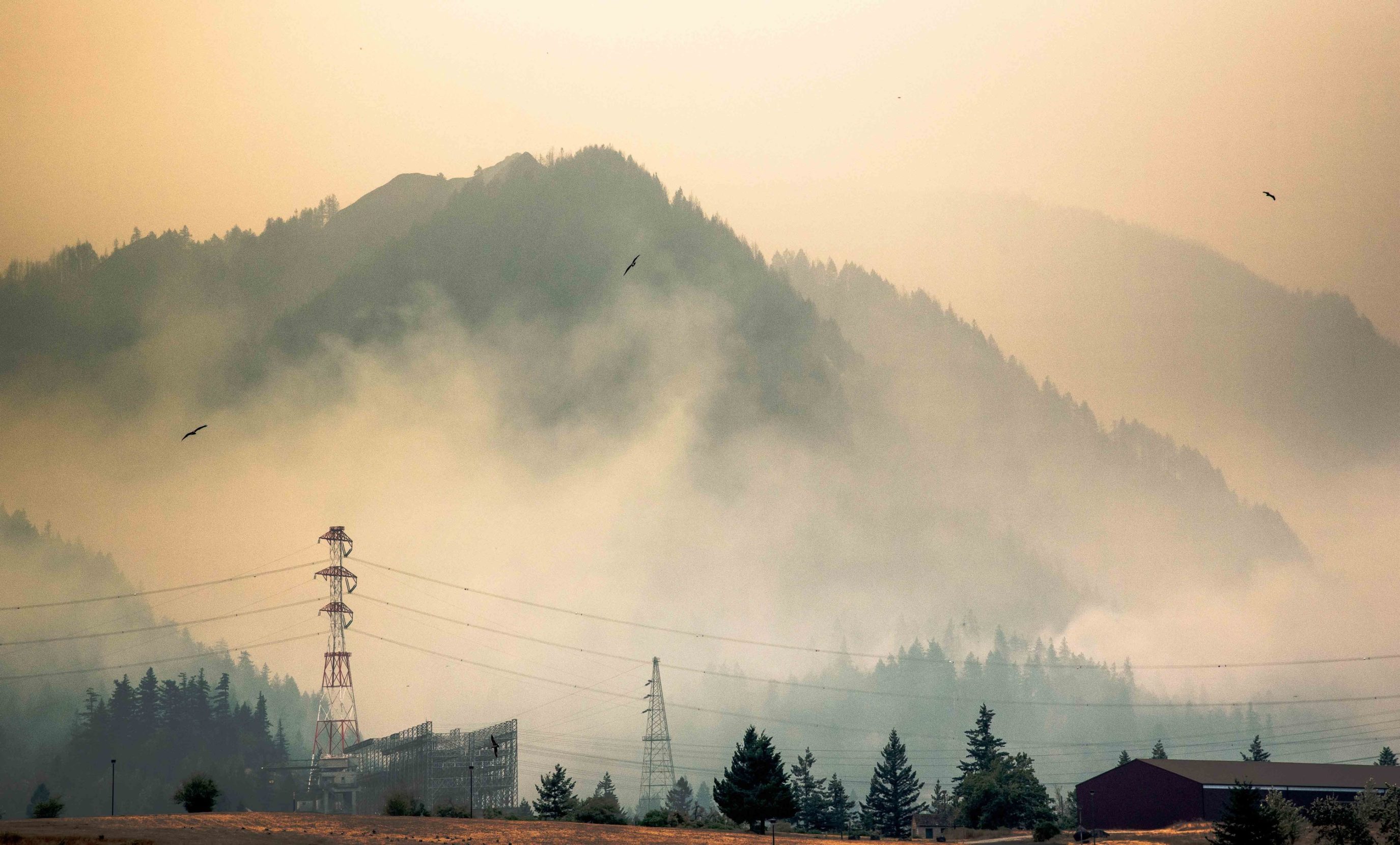
Smoke from the 2017 Eagle Creek fire wafts along the Columbia River Gorge. Several years later, Shoshi Parks confronted a similar scene as the Columbia River Gorge burned once again. Photo: U.S. Army Photo/Alamy.
~~
Back in 1836, two days of high winds left Narcissa and her party stuck in this gorge, unable to move. The deep, narrow channels of the Columbia ran too fierce and swift to navigate. As they waited on the river’s shore, Narcissa was soon miserable.
“I had just seated myself in the shade of the rock, ready to commence work, when, feeling something unusual on my neck, I put my hand under my cape and took from thence two insects, which I soon discovered to be fleas,” she wrote later. “Immediately I cast my eyes upon my dress before me, and, to my astonishment, found it was black with these creatures, making all possible speed to lay siege to my neck and ears. This sight made me almost frantic … To stand still, I could not. I climbed up the rock in pursuit of my husband, who soon saw and came to me. I could not tell him but showed him the cause of my distress. On opening the gathers of my dress around my waist, every plait was lined with them. Thus they had already laid themselves in ambush for a fresh attack. We brushed and shook, and shook and brushed, for an hour, not stopping to kill for that would have been impossible.”
This 90-mile stretch of trail from The Dalles to Oregon City was one of the most challenging on the trail, with massive rocks like jagged teeth that tore the river to shreds. Cruising along by boat was too dangerous, so Narcissa’s party paid local Wasco men to carry their canoes and baggage on foot for miles along the worst sections, while the travelers scrambled up and down the rocky cliffs burden free.
~~
In my little blue Honda, I barreled through the gorge at 60 miles an hour, the spectacular landscape jaundiced by the smoke. Is this it? I wondered. Is this dull, lifeless pallor the future of summer in the West? Should I just cut my losses, turn around, and head home to the Bay Area?
But the smoke was in the Bay Area too. Its drifting ash reached all the way to Minnesota, Toronto, Philadelphia. There was literally nowhere to go.
As I drove east, the smoke pried its pestilential fingers through the windows and reached into my throat.
The smoke stalked me into The Dalles, and when I stepped out of the car at the Fort Dalles Museum, it trailed me to the door. Fort Dalles was built as a Methodist mission five years before the Great Emigration of 1843, when a thousand easterners traveled en masse along the Oregon Trail in a feverish blush. It was a welcome stop before the dangerous serrated stretch of the gorge.
This is the first day of my journey heading east, but by the time they reached the fort, the 19th-century travelers had almost completed their brutal westward trek of more than 2,000 miles. The Oregon-California Trails Association estimates that 65,000 emigrants — about 1 in 10 — did not survive the westward scramble. There were a million and one ways to die: outbreaks of cholera, accidental shootings, river drownings, untreated injuries left to rot, crushings beneath the wheels of heavy pioneer wagons.
And still, the settlers kept coming. Still they endured.
As the afternoon slipped into evening, the smoke seemed a little lighter. I crossed the river to its northern bank and watched the sun set between the stelae of the Stonehenge Memorial. It sank slowly, in unearthly hues of pink and orange made vivid by the smoke’s lingering haze. Maybe tomorrow the skies will be clear.
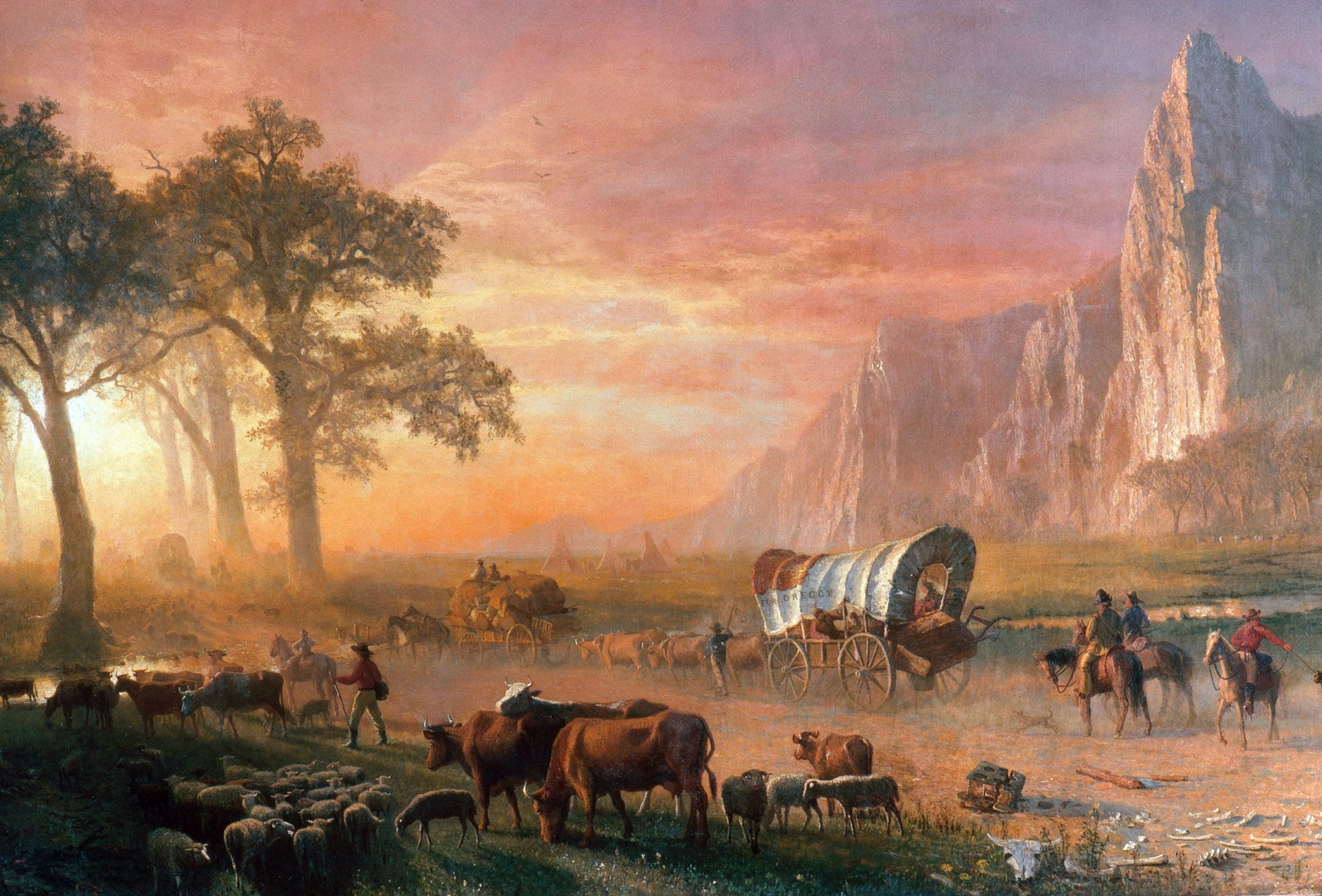
This painting, depicting emigrants on the Oregon Trail, comes from the Hudson River School, an American art movement of New York City-based landscape painters that began around 1850. To paint his sweeping scenes, the German-American artist Albert Bierstadt joined several westward journeys for inspiration. Image: Albert Bierstadt, Sunset on the Oregon Trail , oil on canvas, 31” x 49”.
The Dalles to Baker City — 221 miles
2021: 3.5 hours
1836: 2 weeks
I woke to a morning gray and brown and murky. The smoke was back, dulling the landscape and crushing my optimism. It was already 85 degrees by the time I hit the road, with the Air Quality Index (AQI) hovering around 150 — the pollution level deemed “unhealthy for the general population.”
I stopped for breakfast in Pendleton, a town just outside the Confederated Tribes of the Umatilla Indian Reservation, at the base of the Blue Mountains. This is where the Cayuse, Umatilla, and Walla Walla were moved in 1855, after being forced to cede their territory by the U.S. government.
The Oregon Trail was a lightning strike through the Indigenous communities of the Northwest.
When Narcissa crossed the Blue Mountains in 1836 she dubbed them “the Mount Terribles.” The trail back then was arduous and littered with black basalt that pricked the tender, unshod feet of the horses. “It was like winding stairs in its descent,” she wrote in her journal, “and in some places almost perpendicular … We had no sooner gained the foot of this mountain than another more steep and dreadful was before us.”
They searched for water and a place to set up camp until late that night. Exhaustion weighed on Narcissa and her companions.
“For two or three days past I have felt weak, restless and scarcely able to sit on my horse,” she confided the next day. “If I had no better health to-day than yesterday I should have fainted under it. Then the promise [of Oregon] appeared in full view … It was beautiful.”
Narcissa was one of the first in a long line of emigrants to find the Blue Mountains inhospitable. When Medorem Crawford, a 23-year-old New Yorker, crossed them in early September 1842, their summit was already frosted in heaps of snow.
The trail that led to the foothills of the Blue Mountains was almost as bad, crossing a valley of sagebrush and bunchgrass, with a solitary pine tree standing stalwart in its center. “I believe it is respected by every traveler through this almost treeless country,” wrote Crawford in his journal. And it was, until 1843, when the tree was felled by emigrants desperate for firewood.
“Two mules and a horse have almost entirely given out,” wrote Narcissa. “Perhaps you think we always encamp in the shade of some thick wood. Such a sight I have not seen, lo, these many weeks. If we can find a few small willows or a single lone tree, we think ourselves amply provided for … Sometimes my wicked heart has been disposed to murmur, thinking it should have no rest from the heat when we stopped.”
~~
Increasingly, it feels like the West is no longer a promised land of untold riches. It’s a blasting furnace. A steaming, boiling fumarole. A hellscape of drought and wildfire and smoke.
In the past few years things have gotten worse. The wildfires no longer burn only through late summer and fall, when the land is at its most parched, but year-round. They’ve multiplied exponentially, destroying homes and businesses, wiping out entire towns.
At home, in the Bay Area’s concrete jungle, I’ve been protected from the worst of the fires. On the Oregon Trail I’m more exposed, more vulnerable. But unlike the emigrants, the Indigenous nations they assaulted, and those who now battle the fires outside their doors, I am protected by privilege. For me, the only thing at stake is a summer vacation. My life, my home, my community — they’ll be just fine.
The wildfire smoke, though, doesn’t care who I am. It doesn’t care who’s rich or poor, white or Indigenous. The choking, burning fog affects us all. It forces us indoors day and night, when the haze that blots out the afternoon sky melts into the darkness. It toys with the light, turning it orange and eerie.
The intensity of the droughts will likely increase. The wildfires will likely grow larger and hotter and come closer to human populations. The smoke is expected to increase cases of asthma and lung cancer. (Stanford University researchers estimate that California’s wildfire smoke may have led to as many as 3,000 additional deaths in just the brief period between August 1 and September 10, 2020).
And when the rains do come — if the rains come at all — they’re likely to fall so hard and so fast they’ll trigger landslides, a second round of devastation for fire-ravaged communities.
~~
The smoke thickened with every mile I drove across the immense plain. Ash flung from the nearby Elbow Creek Fire coated everything around me, and again I wondered what I was doing here. I came to experience a journey that changed history. All I’ve found is smoke and heat and an endless highway.
But all day I’d been looking forward to Baker City, where wagon ruts left by the emigrants are still imprinted in the dry, dry plain. I needed to see them. I needed to walk, even just a few yards, in their footsteps. I needed to remember how human endurance can prevail over nearly impossible circumstances, whether a 2,200-mile journey on foot or a disastrously changing climate.
Stepping into the heat was like slamming into a concrete wall. Within seconds the smoke was on me, filling my mouth, forcing runlets of carbon monoxide from my eyes. It held me fast as I placed my left foot, then my right, into the ruts and began to walk.
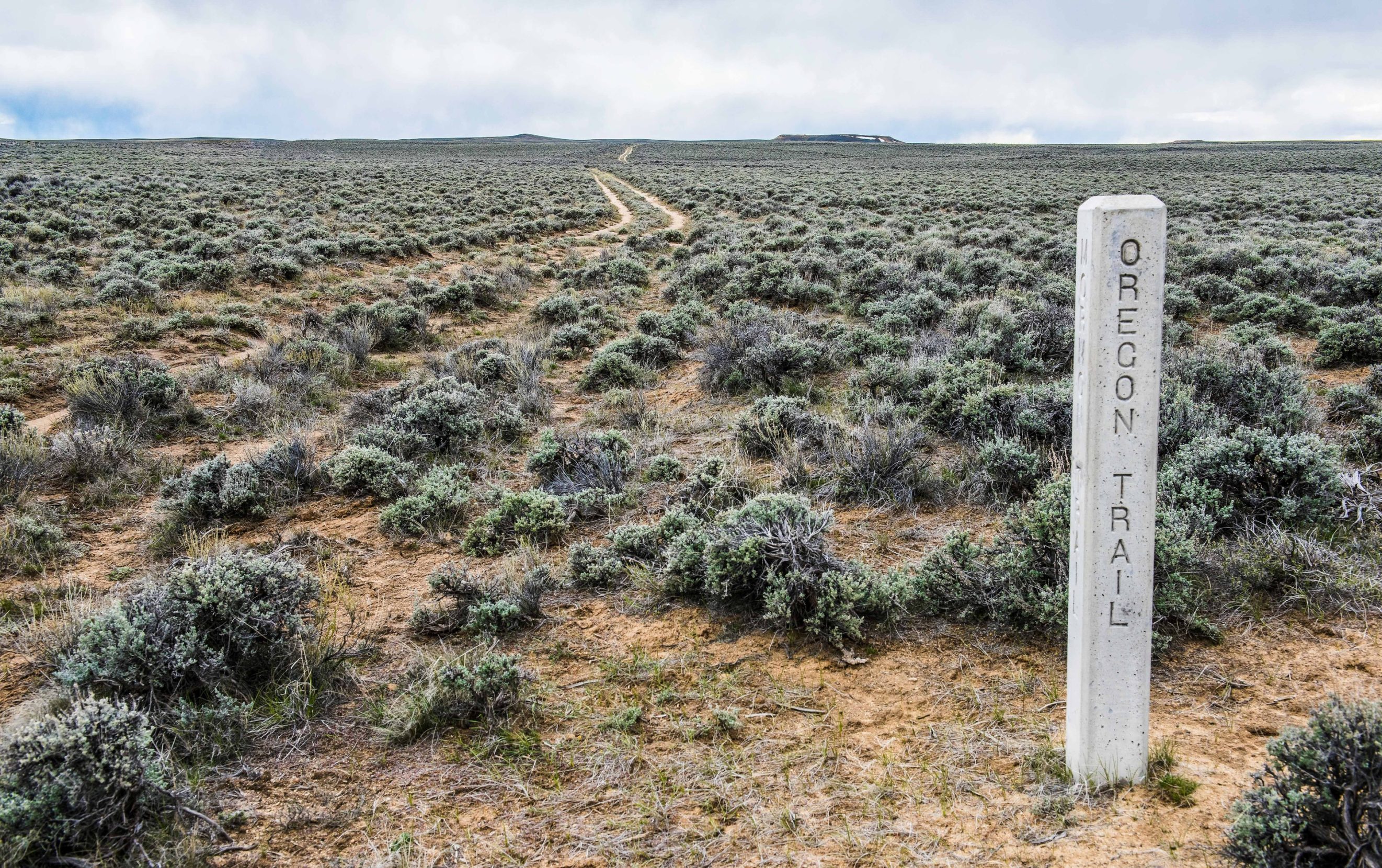
Wagon wheel ruts remain imprinted in the dry earth of Wyoming from the Oregon Trail emigrants who passed through more than a century ago. Photo: Bruce Montagne/Alamy.
Hundreds of thousands of people passed through this spot — exactly this spot — in search of a better life in the West. But the heat is more intense than Narcissa or Crawford or any of them experienced 200 years ago. Even in modern times August temperatures in Baker City typically average 81 degrees Fahrenheit. Today it was over 100.
I didn’t get far before my sight began to swim, and darkness descended like a curtain. The smoke encircled me and settled in my hair as I sat heavily in the ruts, gulping the polluted air, waiting for the wave of heat exhaustion to pass.
“Sometimes my wicked heart has been disposed to murmur, thinking it should have no rest from the heat when we stopped.”
There’s nothing — not a single thing — we can do to stop the growing plague of drought and extreme heat and fire. In the coming years some of us will leave by choice. Others will be forced out when their homes are destroyed by the flames. Some will even lose their lives.
The rest of us, well, we’ll have to learn to endure.
Baker City, Oregon to Boise, Idaho — 128 miles
2021: 2 hours
1836: 4 days
“Left camp at 11 o’clock & traveled briskly over a sandy country suffered considerable for water as the day was exceedingly hot,” Crawford wrote on September 3, 1842, after a night at Fort Boise.
I felt the same way as I backtracked along his route.
When Narcissa arrived, in 1836, Boise’s namesake fort was primarily a fur-trading post run by a French Canadian and, bizarrely, staffed mostly by Native Hawaiians, who’d come on trading ships to labor in the Northwest. By the time Crawford arrived, in 1842, it was a wooden bunker built to protect Euro-American intruders from the Shoshone, on whose land they’d plunked down the fort without permission.
Within 20 years of Narcissa’s crossing, the geopolitics of the region had changed. An area once shared among the Bannock, Nez Perce, Klamath, Modoc, Wasco, and more than a dozen other tribes had become a U.S. territory studded with private homesteads and burgeoning towns. In travel guides written for emigrants, like the one published by Lansford Hastings in 1845, guns and ammunition are described as indispensable both for dispatching “Indians” and buffalo.
“Should you come in mortal conflict with the former, the rifle will be found to be much more effective [than the pistol],” wrote Hastings, a Confederate soldier and explorer perhaps best remembered today for promoting the ill-fated shortcut to California that drove the Donner Party to cannibalistic desperation in 1846.
In truth, Native people had far more to fear from the emigrants than the other way around. Between 1840 and 1860, 426 Indigenous people were slain by emigrants (362 emigrants were killed by Native people). But thousands more succumbed to measles, cholera, and other diseases against which they had no natural immunity. By the 1860s they’d lost almost everything: Their people were murdered, their land was stolen, hell, even their spiritual traditions were made illegal by the federal government until 1978.
And still, they held tight to their devastated land. Still they resisted the onslaught. Still they survived.
I’ve always wanted to know … what it was like at that time, in that place — on a journey that forever changed the future of the West.
At the fort Narcissa washed clothes for only the third time since leaving Missouri. An invitation to stay on through the Sabbath, she wrote, was “a favor for which we can never be too thankful, for our souls need the rest [as well as] our bodies.” The Whitmans left their wagons and cattle behind when they departed the next day. “Our animals were failing, and the route in crossing the Blue Mountains is said to be impassable … ”
That night they camped along the Snake River, which had to be crossed the next morning. “The first and second places were very deep, but we had no difficulty in crossing on horseback,” Narcissa wrote.
The third crossing was deeper still, but just as I am today, traveling in my air-conditioned cocoon, Narcissa was protected by her skin color and class:
“This being a fishing post of the Indians [likely members of what are today the confederated Upper Snake River Tribes], we easily found a canoe, made of rushes and willows, on which we placed ourselves and our saddles, when two Indians on horseback, each with a rope attached to the canoe, towed us over. We were favorites of the company. No one else was privileged with a ride on it.”
I too had planned to camp along the Snake River, but the smoke was relentless. I waited almost until nightfall, hoping that maybe, just maybe, it would lift. If the AQI would just drop to 130, I told myself, I’d pitch my tent in the open air.
Instead the smoke chased me into a roadside motel.
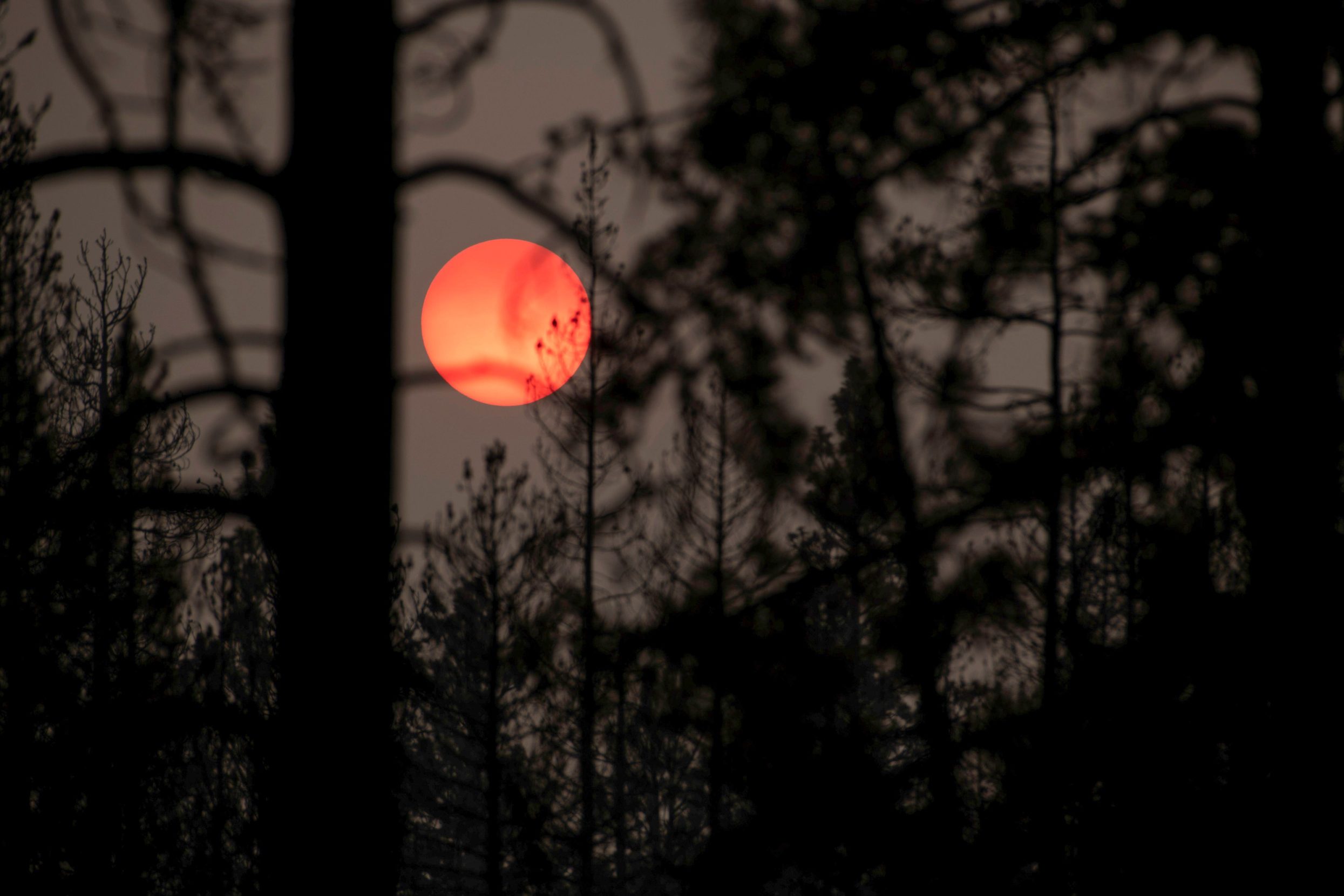
Wildfire smoke in the forests of Oregon causes the sun to cast a haunting orange glow. Photo: Mathieu Lewis-Rolland/Alamy.
Boise to Twin Falls — 128 miles
2021: 2 hours
1836: 12 days
My last day on the Oregon Trail followed it through rocky hills and the dry, sandy desert of southwestern Idaho.
In 1836 there was either no water (and therefore no grass for the horses and oxen), or there was far too much water — swollen rivers that the emigrants and their pack animals had no choice but to ford. Narcissa’s husband nearly drowned two of their mules trying to get their wagon across the Snake River.
I reached the Snake River Canyon in the late morning — “a tremendous valley with banks of perpendicular rock at least 200 feet high,” as Crawford described it. Its steep banks are so dramatic that daredevil “Evel” Knievel tried to fling himself across the mile-wide chasm on a steam-powered rocket motorcycle in 1974. (He didn’t make it. Though thanks to his parachute, he didn’t buy it either.)
~~
Historians call the Oregon Trail “the nation’s longest graveyard.” Narcissa survived her journey, but she didn’t live long. Following a measles outbreak among the Cayuse in 1847, the tribe retaliated against Narcissa, Marcus, and 11 other Anglos in what has come to be known as the Whitman Massacre. The violence put an end to 11 years of Christian assaults on the minds, bodies, and spirits of the Cayuse, and to the Waiilatpu mission.
Maybe it was also a mercy for Narcissa. Her Oregon dream died on the day in 1839 when her two-year-old daughter, Alice, drowned in the Walla Walla River. In her letters home, Narcissa writes of her loneliness, depression, and indifference to her missionary work. By 1847 she was just a shell of the first white woman who had dared to travel the Oregon Trail.
The Cayuse destroyed the Whitmans’ mission, but neither they nor anyone else could stanch the flow of the Oregon Trail.
“Then the promise [of Oregon] appeared in full view … It was beautiful.”
It’s still too early to know if the consequences of a changing climate will, for the first time since the early 19th century, trigger a never-before-seen reverse migration out of the American West. But “one thing is clear,” wrote Alan Buis in a NASA blog last year. “Fires are likely to become an increasingly consequential fact of life as the U.S. West continues to get warmer and drier. Society will need to adapt.”
The West is no longer the paradise that Narcissa and other emigrants on the Oregon Trail endured months of walking, disease, disaster, and near starvation to reach. Can we in the West today endure the consequences of the changing climate, the unknown diseases and disasters to come?
~~
Later that afternoon in Twin Falls, I stood above Shoshone Falls, aka the Niagara of the West. The smoke followed me there too, but I was so overwhelmed by the cataract’s beauty that my boiling lungs dulled to a simmer in my chest.
I’ve traveled the world, seen more than most, and still the West captures my imagination like nowhere else on Earth. It is my home. If adapting is what it takes to survive what’s to come, then I will adapt. I will endure.
“Under the circumstances I have never wished to go back,” wrote Narcissa from the trail in 1836. “Such a thought never finds a place in my heart.”
Nor do I, Narcissa. Under the circumstances, I have never wished to leave. Such a thought never finds a place in my heart.
Shoshi Parks
Shoshi Parks is an anthropologist turned writer of the quirky and fascinating.

